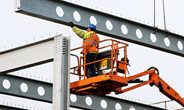Analysis

August 20, 2021
AGC: Construction Jobs Still Trailing in Many States
Written by David Schollaert
Construction employment is still trailing peak pre-pandemic levels in 36 states, reports the Associated General Contractors of America (AGC) in its latest analysis of government data.
As the Delta variant threatens to hold down further gains, the AGC stressed that construction employment would benefit from new federal infrastructure investments, urging the House to quickly pass the bipartisan bill.
“This data shows that full recovery remains elusive for construction in most states,” said Ken Simonson, AGC’s chief economist. “In fact, the fast-spreading COVID-19 Delta variant may make it harder to find employees eligible to work on restricted sites and may also depress demand if some owners defer projects.”
Since the peak seen last February through July 2021, construction employment increased in only 14 states and was flat in the District of Columbia. Texas shed the most construction jobs over the period, a loss of 56,200 jobs or 7.2%, followed by New York and California. Louisiana recorded the largest percentage loss, down 15.3% or 21,000 jobs, followed by Wyoming and New York.
Of the states that added construction jobs since February 2020, Utah added the most at 7,900 new payroll positions or 6.9%, followed by North Carolina and Idaho. The largest percentage gain was in Idaho at 8.2% or 4,400 new jobs, followed by South Dakota and Utah.
July construction employment decreased in 18 states versus June, while 30 states posted increases. Kansas, Tennessee and D.C were unchanged during the same period. The largest decline month on month in July was Colorado, which lost 1,600 construction jobs or 0.9%, followed by a loss of 1,500 jobs each in Oklahoma, Texas and Pennsylvania. The steepest percentage declines since June occurred in New Hampshire, a decrease of 2.2% or 600 jobs, followed by 1.9% losses in Oklahoma and Arkansas.
North Carolina added the most construction jobs in July at 4,300 new positions added to payrolls or 1.8%, followed by New Jersey and Illinois. The largest percentage gains were in New Jersey and Connecticut at 2.7%, followed by South Carolina.
The AGC warned that construction employment was being impacted in many parts of the country because of supply chain challenges and growing market uncertainty caused by the resurgent Delta variant. New federal infrastructure investments would provide a needed boost in demand and help put more people to work in construction careers, added the association.
“New federal infrastructure investments will help put more people to work in high-paying construction careers,” said Stephen Sandherr, AGC’s CEO. “The House can help put Americans back to work by immediately approving the infrastructure measure that passed the Senate with broad bipartisan support.”







